Chapter 4 Structure Of Atom
As we have learnt in previous chapters, Matter is anything that occupies space and has mass and is made up of tiny particles called as atom. Different types of matter exists because of the different atoms that consists them. Now the question that comes to the mind is that: (i) how these atoms are different from each other? (2) Is it true that the atoms are indivisible, or they can be further divided?
These answers will be provided it the following chapter, where we will learn about the sub-atomic particles and how they were discovered. This chapter will also entail the reason behind the different properties of atoms due to which the matter is varied.
At the end of the 19th century, scientists were facing difficulties to reveal the actual structure of atom and were not able to explain the properties associated with them. There were series of experiments that elucidated the structure of atom.
Atoms are not divisible was first indicated by the study of static electricity and the conditions under which they are conducted.
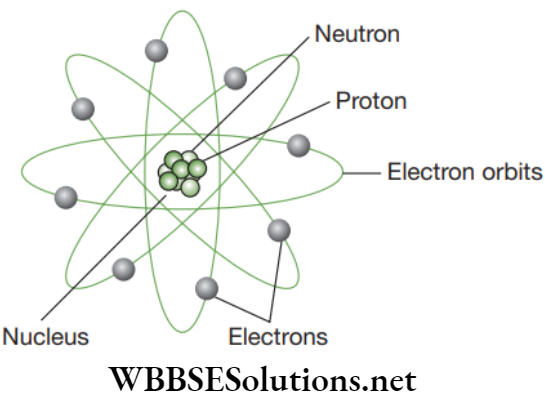
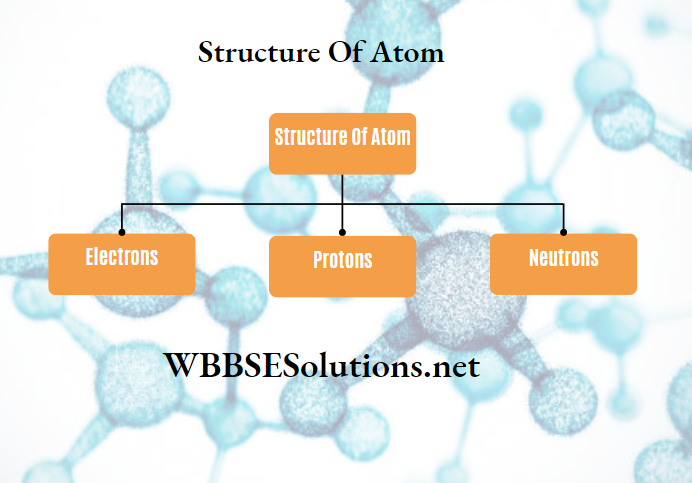
Chapter 4 Structure Of Atom Charged Particles in Matter
There are almost 120 known elements in the periodic table. The atoms of different elements have different numbers of electrons, protons, and neutrons. Every element is unique and has an atomic number. That number tells you the number of protons in every atom of the element. The atomic number is also called the proton number.
Read and Learn More: NEET Foundation Notes
Atom is labeled with a “+”, “−”, or a “0.” Those symbols refer to the charge of the particle. Charges are also found in tiny particles of matter.
The electron always has a “−”, or negative charge. The proton always has a “+”, or positive charge. If the charge of an entire atom is “0”, or neutral, there are equal numbers of electrons and protons. The third particle is the neutron. It has a neutral charge, also known as a charge of zero.
Electrons
Electrons are negatively charged particles, which were discovered by J. J. Thomson in cathode ray experiment. The term electron was coined by GJ Stoney.
How the Electrons were Discovered?
J. J. Thomson constructed a glass tube from which the air was pumped out and a high electrical voltage among the two electrodes which was placed at either end of the tube was is applied.
He detected that a stream of particle coming out from the negatively charged electrode called cathode to positively charged electrode called anode. This ray is called cathode ray, whole construction is called cathode ray tube and the particles were called electrons.
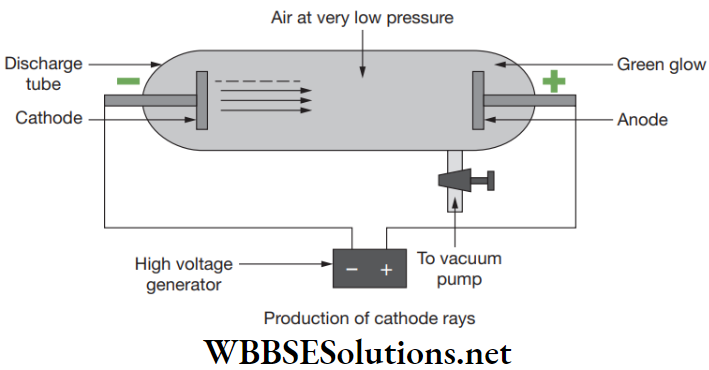
Protons
E Goldstein, in 1886 found that anode emits positively charged particles called protons in an anode ray experiment. These positively charged radiations are produced in discharge tube from the anode called canal rays. In 1909, Rutherford discovered proton in his famous gold foil experiment.
Neutrons
Neutrons were discovered by James Chadwick in 1932 and are neutrally charged particles. It stays inside the nucleus of an atom except hydrogen.
Comparison of three sub-atomic particles

How to Determine the Number of Proton, Electron and Neutron?
Gather Information
Find some information about your element, such as its atomic number (located in the upper left corner) and atomic weight (located on the bottom).
Consider an example for Krypton:
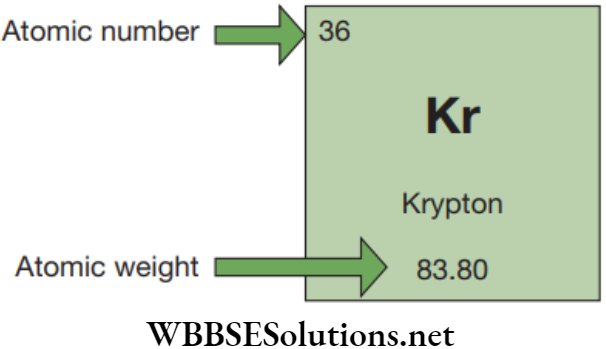
Find the Number of Protons
The atomic number is the number of protons in an atom of an element. In our example, Krypton’s atomic number is 36, so it has 36 protons in its nucleus.
Find the Number of Electrons
Atoms must have equal numbers of protons and electrons. So, atom of Krypton must contain 36 electrons since it contains 36 protons.
Find the Number of Neutrons
The atomic weight measures the total number of particles present in an atom’s nucleus. As the nucleus is made up of protons and neutrons. So,
Mass Number = (Number of Protons) + (Number of Neutrons)
For Krypton, this equation becomes:
84 = (Number of Protons) + (Number of Neutrons)
84 = 36 + (Number of Neutrons) {Number of proton is calculated above}
Number of neutrons = 84 − 36
Number of neutrons = 48
Chapter 4 Structure Of Atom Master your Test Question And Answers
Question 1. Define atomic number.
Answer.
Atomic Number:
The atomic number is the number of protons in an atom of an element.
Question 2. Define atomic mass.
Answer.
Atomic Mass:
The atomic weight measures the total number of particles present in an atom’s nucleus. As the nucleus is made up of protons and neutrons. So,
Mass number = (Number of Protons) + (Number of Neutrons)
Question 3. What are canal rays?
Answer.
Canal Rays:
These positively charged radiations are produced in discharge tube from the anode called canal rays.
Question 4. What is the relative mass of neutron?
Answer.
Relative mass of neutron:
A neutron is 1842 times heavier than electron.
Question 5. Define nucleon.
Answer.
Nucleon:
A nucleon is the sub-atomic particle found in the nucleus of an atom.
Chapter 4 Structure of an Atom
Atomic models mainly explain the structure of an atom and also gave us an idea about how subatomic particles behave.
Thomson Model or Water Melon or Plum Pudding Model
In 1897, Thompson proposed that the structure of an atom is similar to that of a Christmas pudding. In this, atom is a positively charged sphere in which the electrons are embedded and the magnitude of positive and negative charge is same inside an atom so the net charge inside an atom is zero.
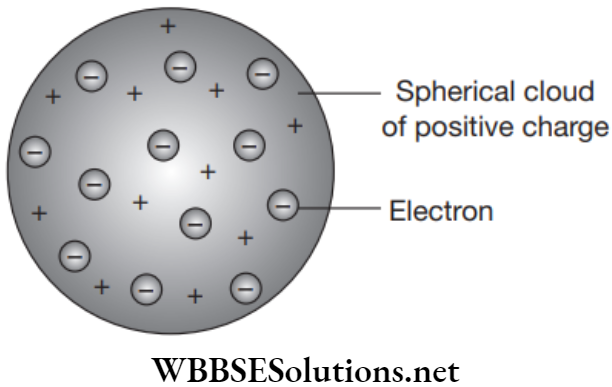
Limitations
- It could not explain the result of scattering experiment performed by Rutherford.
- It did not give any experimental evidence in its support.
Rutherford’s Model or Planetary Model
In gold foil experiment, Rutherford bombarded a beam of alpha particles on an ultrathin gold foil of thickness about 1000 atoms. He uses alpha particles, as these are doubly charged helium ions which moves fast and has a considerable amount of energy.
Method
Fast moving alpha particles were bombarded on thin gold foil and after passing to the foil they hit the screen.
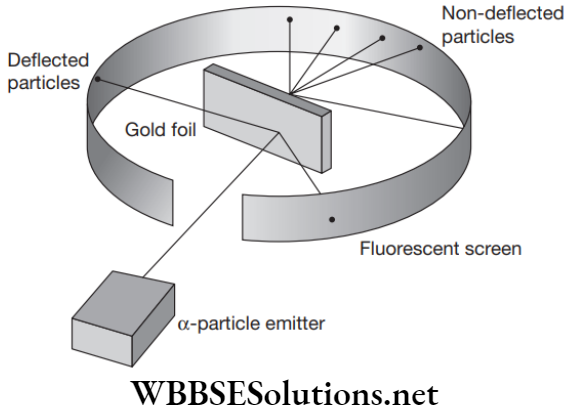
Observations
- Most of the alpha particles pass through the foil without getting deflected, which means that most of the space inside the atom is empty.
- Some of the alpha particles were deflected by small angle, which means that the positive charge of the atom occupies very little space.
- Some of the alpha particles rebound back, which means the entire positive charge and mass of the atom is concentrated in a very small volume inside an atom.
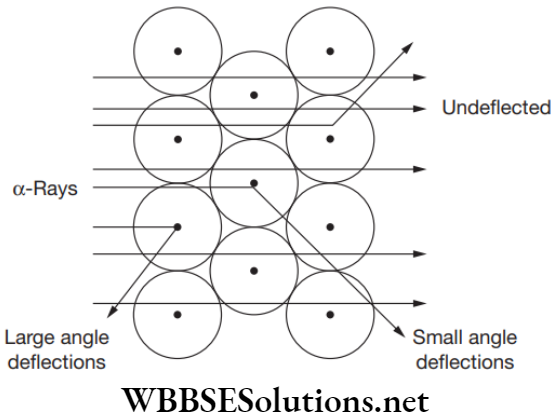
Conclusions
- All the positively charged particles are present in small space inside the atom called nucleus.
- Electrons revolve around the nucleus.
- Most of the space inside an atom is empty.
- Total positive charge in nucleus is same as total negative charge on all electrons of atom, so the net charge of an atom is zero.
Limitations
- Rutherford proposed that the electrons revolve around the nucleus in fixed paths called orbits. But according to Maxwell, an accelerated charged particle such as electron always emits an electromagnetic radiation and this radiation would carry energy from the motion of the electron which would come at the cost of shrinking of orbits. So, the electrons would collapse in the nucleus.
- Rutherford did not say anything about the arrangement of electrons in an atom.
Bohr’s Atomic Model
In 1913, Neil Bohr proposed a model of atomic structure.
He proposed:
- Electrons revolve around a positively charged nucleus in a certain orbit.
- The whole mass of the atom is concentrated in the nucleus.
- Electrons while revolving in an orbit do not radiate energy.
- Orbits or shell are called energy levels, and are represented by the letter K, L, M, N … or by numbers n = 1, 2, 3 …
- Energy level is associated with the definite amount of energy.
- Energy changes when an electron jumps from one energy level to another.
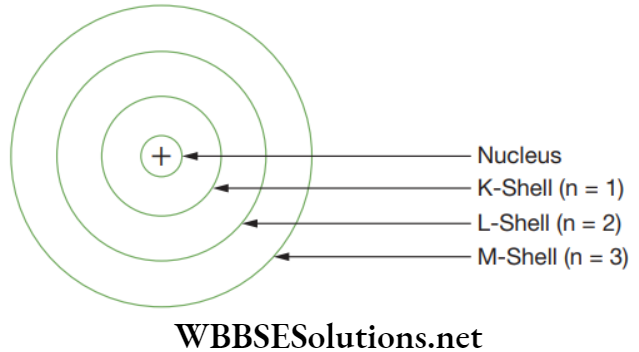
With his model, Bohr explained how electrons jump from one orbit to another either by emitting or absorbing the energy in fixed quanta. Like, if an electron jumps from one orbit which is closer to the nucleus, it must emit energy which is equal to the difference of the energies of the two orbits.
Similarly, when an electron jumps to a larger orbit, it absorbs a light equal in energy to the difference in orbits.
Bohr’s orbits are called stationary states because the energies of orbits in which the electrons revolve are fixed.
Photoelectric Effect
There is immediate ejection of electrons from the surface of metal when light beam of certain frequency strikes on it. This is known as the photoelectric effect.
Heisenberg’s Uncertainty Principle
This principle states that it is impossible to decide both simultaneously and accurately position and momentum of a microscopic moving particle.
Quantum Numbers
They are used to specify the orbitals and the electrons. We will also discuss the principal quantum number, azimuthal quantum number, spin and magnetic quantum number.
Pauli’s Exclusion Principle
It is not possible for an atom to have all 4 quantum numbers same for two electrons.
Hunds’ Rule of Maximum Multiplicity
The pairing of orbitals of the atom is started only when each orbital has occupied one electron.
Schrödinger Wave Equation
The Schrödinger wave equation is used to find the probability of presence of electron. This place where probability of finding electron is highest is known as orbital.
Chapter 4 Structure Of Atom Master your Test Question And Answers
Question 1. What are the limitations of Thomson’s plum pudding model?
Answer.
The limitations are:
- It could not explain the result of scattering experiment performed by Rutherford.
- It did not give any experimental evidence in its support.
Question 2. What are the observations of Rutherford’s model?
Answer.
Observations of Rutherford’s Model were:
- Most of the alpha particles pass through the foil without getting deflected, which means that most of the space inside the atom is empty.
- Some of the alpha particles were deflected by small angle, which means that the positive charge ofthe atom occupies very little space.
- Some of the alpha particles rebound back, which means the entire positive charge and mass of theatom is concentrated in a very small volume inside an atom.
Question 3. What are the limitations of Rutherford model?
Answer.
The limitations of Rutherford’s model were:
- Rutherford proposed that the electrons revolve around the nucleus in fixed paths called orbits. Butaccording to Maxwell, an accelerated charged particle such as electron always emits an electromagnetic radiation and this radiation would carry energy from the motion of the electron which would come at the cost of shrinking of orbits. So, the electrons would collapse in the nucleus.
- Rutherford did not say anything about the arrangement of electrons in an atom.
Chapter 4 Structure Of Atom Track Your learning Question And Answers
Question 1. The is immediate ejection of electrons from the surface of metal when light beam of certain frequency strikes on it is known as the ____________.
Answer. Photoelectric effect
Question 2. The Schrödinger wave equation is used to find the probability of presence of electron. (True/False)
Answer. True
Question 3. The place where probability of finding electron is highest is known as ____________.
Answer. Orbital
Question 4. ____________ are used to specify the orbitals and the electrons.
Answer. Quantum numbers
Question 5. Electrons while revolving in an orbit radiate energy. (True/False)
Answer. False
Chapter 4 Structure Of Atom Distribution of Electrons in Different Orbits
Electronic configuration is an arrangement of electrons in various shells of an atom of the element.
Electronic configurations describe electrons as each moves independently in an orbital. Mathematically, configurations is described by Slater determinants or configuration state functions.
According to the laws of quantum mechanics, if systems have only one electron, then its energy is associated with each electronic configuration and, on certain conditions, electrons are able to move from one configuration to another either by emitting or absorbing the quantum of energy, in form of photon.
Maximum number of electron which can be accommodated in any energy level is 2n2, where n = 1, 2, 3 … The maximum number of electrons which can be placed in an orbit is 8. Stepwise filling of shells is followed, like unless and until earlier shell is filled then only it can accommodate another shell.
Filling of orbits takes place from inside to outside. Maximum number of electrons in a given shell are:
- K-shell, n = 1: Maximum electrons = 2n2, 2(1)2 = 2
- L-shell, n = 2: Maximum electrons = 2n2, 2(2)2 = 8
- M-shell, n = 3: Maximum electrons = 2n2, 2(3)2 = 18
- N-shell, n = 4: Maximum electrons = 2n2, 2(4)2 = 32
Examples:
Electronic Configuration of Hydrogen (H)
Atomic number of hydrogen = 1
So, number of electrons = 1
Maximum number of electrons in 1st orbit = 2
Since, hydrogen has only one electron, so, it will reside in 1st orbit i.e in K-shell
Thus, electronic configuration of hydrogen:
Hydrogen and number of orbit present in hydrogen = 1
Electronic Configuration of Lithium (Li)
Atomic number of Lithium = 3
So, number of electrons = 3
Since the maximum number of electrons in 1st orbit, i.e., in K-shell= 2, so, after accommodating 2 electrons in 1st orbit, the third electron will go in 2nd orbit, i.e., in L-shell
Thus, electronic configuration of lithium is: Lithium and number of orbit in Lithium atom = 3.
Electronic Configuration of Calcium (Ca)
Atomic number of calcium = 20
So, number of electrons = 20
Electronic configuration of calcium is: Calcium and number of orbit in calcium = 4
Chapter 4 Structure Of Atom Master Your Test Question And Answers
Question 1. Define electronic configuration.
Answer.
Electronic configuration:
Electronic configuration is an arrangement of electrons in various shells of an atom of the element.
Question 2. Explain the symbol 16O8.
Answer.
Symbol 16O8
It shows that oxygen has a mass number of 16 and atomic number is 8.
Question 3. Draw the electron dot structure of Chlorine (atomic number 17).
Answer.
The electron dot structure of Chlorine (atomic number 17):
Chlorine (Cl) –2, 8, 7
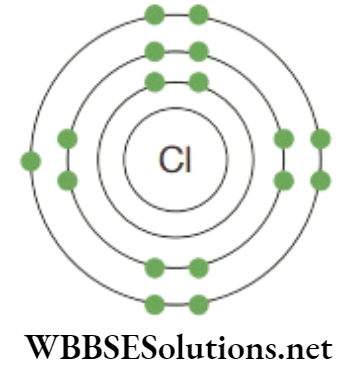
Chapter 4 Structure Of Atom Track Your learning Question And Answers
Question 1. Electronic configurations describe ________ as each move independently in an orbital.
Answer. Electrons
Question 2. Mathematically, configurations is described by _________.
Answer. Slater determinants
Question 3. The maximum number of electrons which can be placed in an orbit is:
- 8
- 7
- 5
- 4
Answer. 1. 8
Question 4. Filling of orbits takes place from __________.
Answer. Inside to Outside
Chapter 4 Structure Of Atom Valency
It is the number of electrons which an atom must either give away or take in order to attain a stable electronic configuration. Valence electrons are the electrons present in the outermost orbit of an atom, thus determining the valency of an atom. Atom can obtain a stable configuration, either by:
- Losing an electron
- Gaining an electron
- Sharing an electron
Valency = 8-valence electrons
Example:
Sulphur: It has 16 electrons.
Electronic configuration: n = 1, or K=1: 2 electrons
n = 2, or L = 2: 8 electrons
n = 3, or M = 3: 6 electrons
Its electronic configuration is 2,8,6. It has six electrons in its outermost orbit, so it requires two more electrons to complete its outermost orbit (M-shell). So it either takes two electrons to other atom or share electrons from another atom just to complete its octet.
Magnesium: It has 12 electrons.
Electronic configuration: n = 1, or K=1: 2 electrons
n = 2, or L = 2: 8 electrons
n = 3, or M = 3: 2 electrons
Magnesium molecule has an electronic configuration 2,8,2. It has two electrons in its outermost orbit, so it requires six more electrons to complete its outermost orbit (M-shell). So it will either donate its two electrons to other atom or share electrons from another atom just to complete its octet.
Valency of some elements
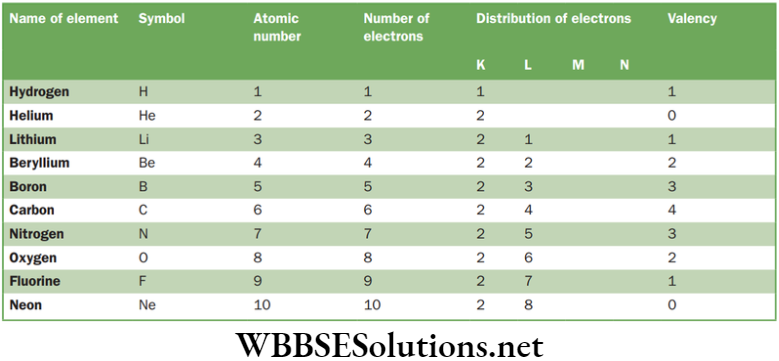
Chapter 4 Structure Of Atom Master Your Test Question And Answers
Question 1. How can an atom obtain a stable configuration?
Answer.
Atom can obtain a stable configuration, either by:
- Losing an electron
- Gaining an electron
- Sharing an electron
Question 2. What are valence electrons?
Answer.
Valence electrons:
Valence electrons are the electrons present in the outermost orbit of an atom, thus determining the valency of an atom.
Question 3. Why Magnesium ion exists as Mg2+?
Answer.
Magnesium ion exists as Mg2+
Magnesium molecule has an electronic configuration 2,8,2. It has two electrons in its outermost orbit, so it requires six more electrons to complete its outermost orbit (M-shell). So, it will either donate its two electrons to other atom or share electrons from another atom just to complete its octet. Master your Test
Chapter 4 Structure Of Atom Track Your learning Question And Answers
Question 1. ____________ = 8 valence electrons.
Answer. Valency
Question 2. ____________ is the number of electrons which an atom must either give away or take to attain a stable electronic configuration.
Answer. Valency
Question 3. ____________ has an electronic configuration of 2,8,6.
Answer. Sulphur
Question 4. Valency of carbon is 4. (True/False)
Answer. True
Chapter 4 Structure Of Atom Atomic Number and Mass Number
Atomic Number
It is represented by Z. It is the number of protons which are present in the nucleus of an atom. The conventional symbol Z comes from the German word Atom zahl which means atomic number.
It uniquely identifies a chemical element, it’s an uncharged atom, and an atomic number is also equal to the number of electrons.
Atomic number = number of proton
As number of proton is equal to number of electron in an atom, so:
Atomic number = number of proton = number of electron
Example, carbon’s atomic number (Z) is 6 as it has 6 protons. The number of neutrons may vary to produce isotopes, which are atoms of the same element that have different numbers of neutrons. The number of electrons can also be different in atoms of the same element, thus producing ions. For example, iron, Fe, can exist in its neutral state, or in the +2 and +3 ionic states.
Atomic number of some elements
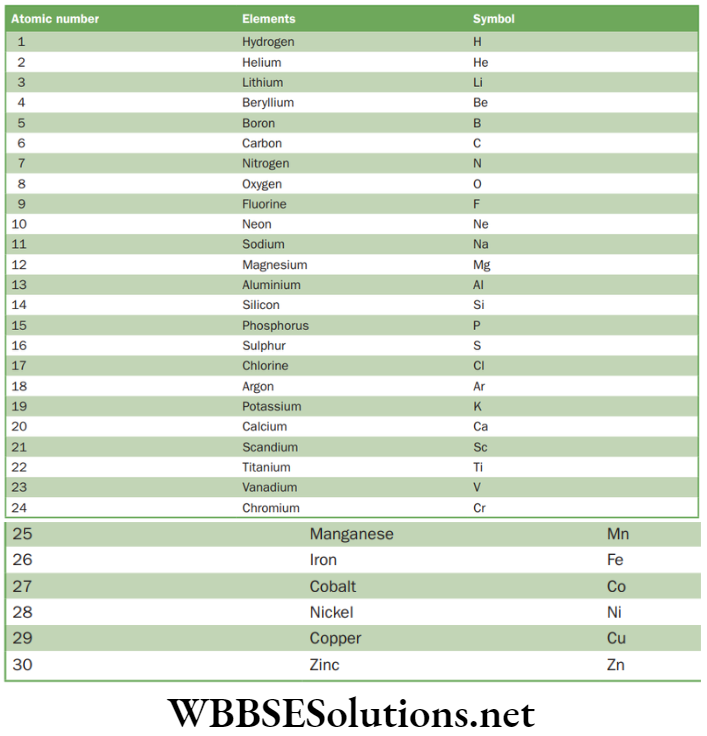
How to calculate atomic number?
To calculate the atomic number for krypton: 3684Kr
Number of Protons = Atomic Number = 36
Number of Electrons = Number of Protons = Atomic Number = 36
Mass Number or Nucleon Number
It is the total number of neutrons and proton present in an atom. It is represented by A.
Mass number = Number of protons + number of neutron
To calculate the number of neutrons in an atom
- Number of Neutrons = Mass Number (A) − Atomic Number (Z)or,
- Number of Neutrons (in an atom) = Nucleon Number (A) − Proton Number (Z)
The atomic number, Z, must not be confused with the mass number, A, as mass number is the number of nucleons i.e., the total number of protons and neutrons present in the nucleus of an atom. The number of neutrons, N, is known as the neutron number of the atom.
Thus, A = Z + N.
Where: A = Mass number
Z = Atomic number
N = Number of neutrons.
Protons and neutrons have approximately the same mass and the mass defect of nucleon binding is small as compared to the nucleon mass, the atomic mass of any atom. This approximation of mass is used to calculate the number of neutrons in an element by simply subtracting the number of protons from the mass number.
Example
Carbon:
Mass number is 12
Number of proton = 6 and number of neutron = 6.
Carbon has an atomic number of six and two stable isotopes with mass numbers of twelve and thirteen, respectively. So, its average atomic mass is 12.01.
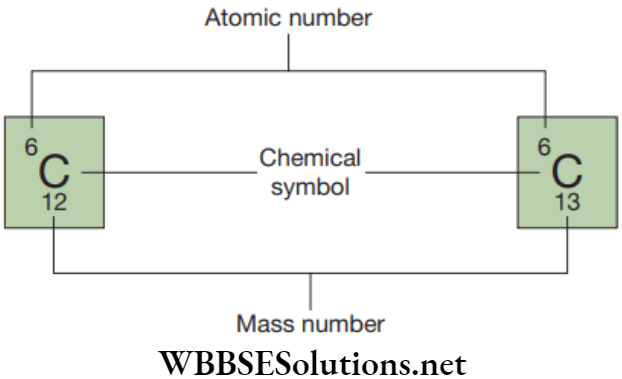
Chapter 4 Structure Of Atom Master your Test Question And Answers
Question 1. What approximation is taken while calculating the number of neutrons?
Answer.
Protons and neutrons have approximately the same mass and the mass defect of nucleon binding is small as compared to the nucleon mass, the atomic mass of any atom. This approximation of mass is used to calculate the number of neutrons in an element.
Question 2. Atomic number of calcium is 20. Calculate the number of electrons and protons in calcium.
Answer.
Since, Atomic number = Number of protons = Number of electronsSo, number of electrons in calcium = 20Number of protons in calcium = 20
Question 3. Atomic mass of aluminium is 27 u and the atomic number is 13, find the number of protons and number of neutrons in aluminium.
Answer.
Atomic number = 13
So, number of proton = 13
Atomic mass (Mass number) = Number of protons + Number of neutrons
Let the number of neutron be ‘n’
27 u = 13 + n
n = 27 − 13 = 14
So, number of proton = 13 and number of neutron = 14
Chapter 4 Structure Of Atom Track Your learning Question And Answers
Question 1. ____________ is the number of protons which are present in the nucleus of an atom.
Answer. Atomic number
Question 2. Atomic number = number of proton = number of electron. (True/False)
Answer. True
Question 3. The number of electrons may vary in an atom to produce isotopes. (True/False)
Answer. False
Question 4. Mass number is the number of ________.
Answer. Nucleons
Question 5. Protons and neutrons have approximately the same mass. (True/False)
Answer. True
Chapter 4 Structure Of Atom Isotopes
Isotopes are the atoms having same number of protons, but different numbers of neutrons, i.e., they have different atomic weights. Isotopes are different forms of a single element. Till now, there are 275 isotopes of the 81 stable elements and over 800 radioactive isotopes have been discovered which are both natural and synthetic. Every element which is present on the periodic table has multiple isotope forms.
The chemical properties of isotopes of a single element are nearly identical. Except the isotopes of hydrogen, as the number of neutrons has a significant effect on the size of the hydrogen nucleus. Physical properties of isotopes are different from each other, as it depends on mass.
So, Isotopes have same atomic number but different mass number and occur due to the presence of different number of neutrons in elements which have a same atomic number as mass number is the sum of the number of neutrons and protons. Not all elements have isotopes.
The isotopes of hydrogen are protium (has one proton and no neutrons) and that of deuterium (has one proton and one neutron) and tritium (has one proton and two neutrons). The chemical properties of isotopes are same as they have same number of protons and hence same number of electrons.
To Indicate Isotopes
- List the mass number of an element after its name or element symbol.
For example, an isotope with 6 protons and 6 neutrons is carbon-12 or C-12. An isotope with 6 protons and 7 neutrons is carbon-13 or C-13. - The mass number may be given in the upper left side of an element symbol.
For example, the isotopes of hydrogen may be written as: 11H, 21H, 31H
Isotopes of hydrogen

Example: Carbon-12 and Carbon-14 are isotopes of carbon, one with 6 neutrons and one with 8 neutrons. Carbon-12 is a stable isotope, while carbon-14 is a radioactive isotope (radioisotope).
Radioactive Isotope
It has an unstable combination of protons and neutrons, and that is why they have an unstable nucleus. Because these are unstable, hence they undergo decay and emit alpha, beta and gamma rays. Radioactive isotopes can be useful in different industries, such as food, agriculture, archaeology and medicine.
Fractional Mass Number
The atomic masses of most elements are fractional as there may be a mixture of isotopes of different masses, so the fractional atomic masses arise because of this mixture.
\(\text { Average mass }=\frac{\text { total mass of all atoms }}{\text { number of atoms }}\)Application of Isotopes
- The identification of primary and secondary food sources.
- Tracing nutrient and mineral uptake by plants and animals.
- Determining the relative importance of plants and microbes to greenhouse gas emissions from soil.
- Measuring environmental stressors by monitoring plant uptake of CO2 and/or water.
- Tracing the sources of catchments waters.
- Isotope of Uranium 23592Ur, is used in nuclear plants to generate electricity.
- The use of isotopes is very common in Isotopic Labelling. Unusual isotopes are used as tracers or markers in chemical reactions.
- Radiations of radioactive isotopes can be used for detecting various reactants, rates, and so on in chemistry.
- Isotopes are used in Radiometric Dating, similar to Radio Isotopic Labelling or Radiocarbon Dating to study chemical processes by using naturally occurring isotopic tracers.
- Isotopic substitution can be used to determine the mechanism of a reaction using Kinetic Isotope Effect.
- Isotopes exhibit different nuclear properties as they have varied numbers of neutrons. This also affects their physical properties.
- Spectroscopy uses many unique nuclear properties of specific isotopes. For example, Nuclear Magnetic Resonance (NMR) spectroscopy can be used only for isotopes with a nonzero nuclear spin. Isotopes commonly used for NMR spectroscopy are 11H, 21D, 157N, 136C, and 3115P.
Isobars
Term “isobars” for nuclides was suggested by Alfred Walter Stewart in 1918 and is derived from the Greek word isos, which means “equal” and baros, means “weight”
Isobars are atoms of different chemical elements having the same number of nucleons. Isobars has different atomic number but same mass number. Example of isobars are 3240S, 3440Cl, 1840Ar, 1940K, and 2040Ca. The nuclei of all these nuclides contain 40 nucleons but are varying in numbers of protons and neutrons.
So, Isobars are the atoms having same mass number but different atomic number. For example, the atomic number of carbon and nitrogen is 6 and 7 respectively.
Example:

Isotones
Isotones are the atoms that have the same neutron number but different number of proton. For example, 3616S, 3717Cl, 3818Ar, 3919K and 4020Ca are all isotones of 20 since they all contain 20 neutrons.
Chapter 4 Structure Of Atom Master your Test Question And Answers
Question 1. Define isotopes.
Answer.
Isotopes:
Isotopes are the atoms having same number of protons, but different numbers of neutrons, i.e., they have different atomic weights.
Question 2. List 3 applications of isotopes.
Answer.
Applications are:
- The identification of primary and secondary food sources.
- Tracing nutrient and mineral uptake by plants and animals.
- Determining the relative importance of plants and microbes to greenhouse gas emissions from soil.
Question 3. Why radioactive elements have unstable nucleus?
Answer.
It has an unstable combination of protons and neutrons, and that is why they have an unstable nucleus.
Chapter 4 Structure Of Atom Track Your learning Question And Answers
Question 1. __________ are the atoms having same mass number but different atomic number.
Answer. Isobars
Question 2. Isotones are the atoms that have the same neutron number but different number of proton. (True/False)
Answer. True
Question 3. _________ are different forms of a single element.
Answer. Isotopes
Question 4. Which of the following exhibit similar chemical behavior?
- Isotopes
- Isotones
- Isobars
- All the above
Answer. 1. Isotopes
Chapter 4 Structure Of Atom Fill in the Blanks
Question 1. The atomic number of an atom having 11 electrons is ____________.
Answer. 11
Question 2. Electrons are ____________ charged particles.
Answer. Negatively
Question 3. ____________ are the smallest of the three particles that make up atoms.
Answer. Electrons
Question 4. There are almost ____________ known elements in the periodic table.
Answer. 120
Question 5. Neutrons were discovered by ____________.
Answer. James Chadwick
Question 6. Mass of an electron is ____________ gram.
Answer. 9 x 10-28
Question 7. ____________ mainly explain the structure of an atom.
Answer. Atomic models
Question 8. Alpha particles are doubly charged ____________.
Answer. Helium ions
Question 9. Electrons revolve around a positively charged nucleus in a certain ____________.
Answer. Orbit
Question 10. The chemical properties of isotopes of a single element are nearly ____________.
Answer. Identical
Chapter 4 Structure Of Atom Match the Column
Question 1. Match the following and choose the correct code:

Select the correct option:
- A-4, B-1, C-3, D-2
- A-2, B-4, C-3, D-1
- A-3, B-4, C-1, D-2
- A-2, B-1, C-3, D-4
Answer. 3. A-3, B-4, C-1, D-2
Question 2. Match the following and choose the correct code:
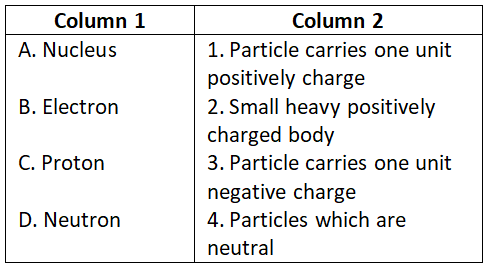
Select the correct option:
- A-2, B-1, C-3, D-4
- A-2, B-3, C-1, D-4
- A-1, B-3, C-4, D-2
- A-3, B-1, C-4, D-2
Answer. 2. A-2, B-3, C-1, D-4
Question 3. Match the following and choose the correct code:
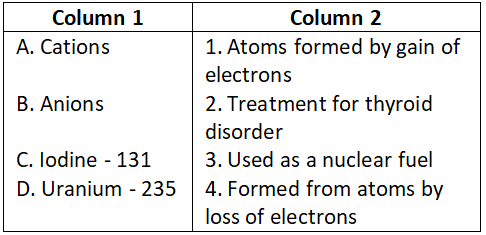
Select the correct option:
- A-3, B-1, C-4, D-2
- A-2, B-3, C-1, D-4
- A-2, B-3, C-4, D-1
- A-4, B-1, C-2, D-3
Answer. 4. A-4, B-1, C-2, D-3
Chapter 4 Structure Of Atom Assertion Reasoning
For the following questions the options will remain the following:
- Both A and R are correct and R is correct explanation of A.
- Both A and R are correct but R is not a logical explanation of A.
- A is correct but R is incorrect.
- R is correct but A is incorrect.
Question 1. Assertion: Cathode rays glow in the entire tube at 1 mm pressure
Reason: The colour emitted depends upon the nature of the gas taken in the tube. If neon gas is taken, the light emitted is reddish orange.
Answer. 2. Both A and R are correct but R is not a logical explanation of A.
Question 2. Assertion: One unit positive charge corresponds to one proton.
Reason: The number of units of positive charge on the nucleus of an atom is equal to the number of protons present in nucleus.
Answer. 1. Both A and R are correct and R is correct explanation of A.
Question 3. Assertion: An atom is positively charged sphere in which electrons are embedded.
Reason: The protons are electrically neutral.
Answer. 3. A is correct but R is incorrect.
Chapter 4 Structure Of Atom Comprehension Passage
As per Thomson’s model of the atom, an atom has both negative and positive charges which are equal in number and magnitude. So, they balance each other as a result of which atom as a whole is eletrically neutral. On the basis of Rutherford’s model of an atom, protons are present in the nucleus of an atom.
If α-particle scattering experiment is carried out using a foil of any metal as thin as gold foil used by Rutherford, there would be no change in observations. But since other metals are not so malleable so, such a thin foil is difficult to obtain. If we use a thick foil, then more α-particles would bounce back and no idea about the location of positive mass in the atom would be available with such a certainty.
The three sub-atomic particles of an atom are protons, electrons and neutrons. An electron is a negatively charged particle, whereas a proton is a positively charged particle. The magnitude of their charges is equal. Therefore, an atom containing one electron and one proton will not carry any charge. Thus, it will be a neutral atom.
If the number of electrons in the outermost shell of the atom of an element is less than or equal to 4, then the valency of the element is equal to the number of electrons in the outermost shell. On the other hand, if the number of electrons in the outermost shell of the atom of an element is greater than 4, then the valency of that element is determined by subtracting the number of electrons in the outermost shell from 8.
The distribution of electrons in chlorine, sulphur, and magnesium atoms are 2, 8, 7; 2, 8, 6 and 2, 8, 2 respectively. The valency of an element is the combining capacity of that element. The valency of an element is determined by the number of valence electrons present in the atom of that element.
Question 1. What will be the valency of the element in the outermost shell of the atom of an element is less than or equal to 4?
- More than the number of electrons.
- Equal to the number of electron.
- Less than the number of electrons.
- No one of above
Answer. 2. Equal to the number of electron.
Question 2. On the basis of Rutherford’s model of an atom where does protons presents?
- In the nucleus of an atom.
- In the neutron of an atom.
- All the protons and neutrons of the atom are contained in the nucleus.
- No one of above
Answer. 1. In the nucleus of an atom.
Question 3. What will happen if α-particle scattering experiment is carried out using a thick foil?
- Particles will cross the foil.
- Particles won’t cross the foil.
- Particles will bounce back.
- Nothing will happen.
Answer. 3. Particles will bounce back.
Question 4. As per Thomson’s model of the atom, what kind of charge an atom consists?
- Positive
- Negative
- Both negative and positive
- No charge
Answer. 3. Both negative and positive
Question 5. How the valency of an element is determined?
- Number of electrons present in the atom of that element.
- Atom containing one electron and one proton.
- The total number of electrons in a carbon atom.
- Atomic number is equal to the number of protons.
Answer. 1. Number of electrons present in the atom of that element.

